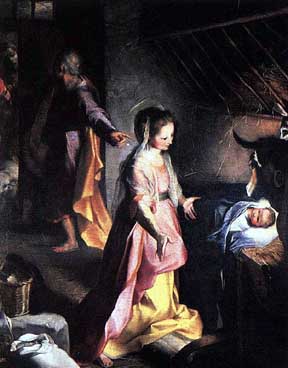SCHEDULE
 Introduction
Introduction
 Mannerism & Baroque
Mannerism & Baroque
 The Absence of Stylistic Unity
The Absence of Stylistic Unity
 From Mannerism to Baroque
From Mannerism to Baroque
 Naturalism
Naturalism
 The Passions of the Soul
The Passions of the Soul
 The Allegorical Tradition
The Allegorical Tradition
 Space
Space
 Time
Time
 Light
Light
 Antiquity
Antiquity

FROM MANNERISM TO BAROQUE
Friedlaender and Wittkower
n.b. 'organic' metaphors used to describe style: "...diagnosed as symptoms of a disease..."; exaggerations of its original nature"; "signs of overbreeding, and hence sterility"
The term maniera - "making by hand" "mode" "style" "manner"
"The [sculptor] needs no model from nature, but follows a specific prototype, or the established precepts of a school. The mechanical attitude engenders conformity or, in other words, "manner".
Unoriginal - repeats manually something predetermined
When this empty stereotyping utilizes forms or formulae inherited from a style already abstract, anormative, and remote from nature, the result must necessarily be something merely decorative or ornamental.
For Friedlaender, mannerism is 'anticlasscial'
two phases of mannerism
- 1520-1550 ("noble, pure, idealistic, abstract")
- 1550-1580 (transformation of first phase into a 'manner' - became di maniera)
An "extraordinary decline in quality" since High Renaissance
'Reform' involved returning to High Renaissance principles ["grandfather law"]
"...the mannered Mannerism of the second phase, against whose shallowness, even in spiritual matters, the reform which set in around 1580 was directed."

(image source: Minor, 1999)
-
Agnolo Bronzino, Martyrdom of Saint Lawrence
S. Lorenzo, Florence, c. 1545-50

(image source Carol Gerten)
-
Agnolo Bronzino, Noli MeTangere (Louvre, Paris)
The Council of Trent and the Arts: Rome 1585-1621 (Rudolf Wittkower)
Council of Trent, least session, December 1561 - defined the role assigned to the arts
Religious imagery was admitted and welcomed as a support to religious teaching
One passage of the decree demands that 'by means of the stories of the mysteries of our Redemption portrayed by paintings or other representations, the people be instructed and confirmed in the habit of remembering, and continually revolving in mind the articles of faith'.
Recommendations of various writers may be summarized under three headings:
- clarity, simplicity, and intelligibility
- realistic interpretation (unveiled truth, accuracy, decorum)
- emotional stimulus to piety
'PC' images ('piously correct') are meant to:
- appeal to the emotions of the faithful
- support or even transcend the spoken word
Most of the artists working roughly between l550 and 1590 practised a style that was
- formalistic
- anti-classical
- anti-naturalistic
- a style of stereotyped formulas
virtuosity of execution and highly decorative surface qualities go with compositional decentralization and spatial and colouristic complexities
deliberate physical and psychic ambiguities puzzle the beholder
intricacies of handling are often matched by the intricacies of content.
many pictures and fresco cycles of the period are obscure and esoteric
little power to stir religious emotions in the mass of the faithful.
lacked clarity, realism, and emotional intensity.
Changes begin to appear from 1580s on
-
Federico Barocci, Nativity
1579 (Prado, Madrid) -
Santi di Tito, Saint Thomas Aquinas Dedicating His Works to Christ
1593 (San Marco, Florence) -
Jacopo Ligozzi, Martyrdom of Saint Catherine
late 1590s (San Francesco, Pescia) - Annibale Carracci, The Dead Christ Mourned, c. 1603
- Caravaggio, Supper at Emmaus, c. 1600

 ART AND THEORY IN BAROQUE EUROPE is produced by Christopher L. C. E. Witcombe, Professor of Art History, Sweet Briar College in Virginia, 24595 USA (phone: 804-381-6194 / fax: 804-381-6494). For more information, please email him at witcombe@sbc.edu
ART AND THEORY IN BAROQUE EUROPE is produced by Christopher L. C. E. Witcombe, Professor of Art History, Sweet Briar College in Virginia, 24595 USA (phone: 804-381-6194 / fax: 804-381-6494). For more information, please email him at witcombe@sbc.edu

